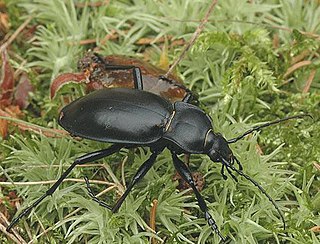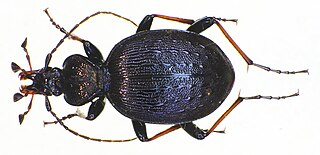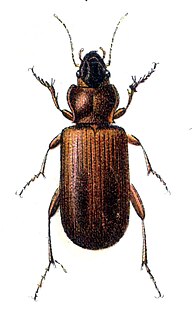
Operation Quicksilver was a Second World War military deception. Undertaken by the Allies in 1944, the operation threatened an invasion of France in the Pas de Calais region through the simulation of a large Field Army in South East England. Quicksilver formed part of the Operation Fortitude deception, itself part of the strategic Operation Bodyguard plan. The key element of Quicksilver was the creation in German minds that "First United States Army Group" (FUSAG) commanded by General George Patton supposedly would land in the Pas-de-Calais for the major invasion of Europe, after the landings in Normandy had lured the German defenders to that front.

Carabus is a genus of beetle in family Carabidae. The genus is highly diverse with 91 subgenera and more than 1000 recognised species and thus is the largest genus in the subfamily Carabinae. The vast majority are native to the Palearctic, but there are also 11 Nearctic species. Carabus are 12–50 mm (0.47–1.97 in) long, most species are wingless and often very colourful. These are nocturnal, predatory beetles that feed on snails, earthworms and caterpillars.

Ant nest beetles or paussines, some members of which are known also as flanged bombardier beetles, are a large subfamily within the ground beetles (Carabidae). The tribes Metriini, Ozaenini, Paussini and Protopaussini are included in the subfamily.

Cychrus is a genus of beetles in the ground beetle family, Carabidae, and includes the following species:

Trechus is a genus of ground beetle native to the Palearctic and the Near East. The name is derived from the Greek word trécho, meaning "I run".
Broscosoma is a genus of beetles in the family Carabidae, containing the following species:
Cychropsis is a genus of beetles in the family Carabidae, containing the following species:
Caledonica is a genus of beetles in the family Carabidae, containing the following species:
Manautea is a genus of beetles in the family Carabidae, containing the following species:

Nebriinae is a subfamily of beetles in the family Carabidae, containing the following genera:

Orthogoniinae is a subfamily of ground beetles. Occasionally it was treated as a tribe Orthogoniini of subfamily Harpalinae, particularly when this was circumscribed loosely.
Orthogonius is a genus of beetles in the family Carabidae, containing the following species:
Eustra is a genus of beetles in the family Carabidae, containing the following species:
Filicerozaena is a genus of beetles in the family Carabidae, containing the following species:
Pachyteles is a genus of beetles in the family Carabidae, containing the following species:
Eucamptognathus is a genus of beetles in the family Carabidae, containing the following species:

Trechinae is a subfamily in the ground beetle family, Carabidae.
Amerizus is a genus of beetles in the family Carabidae, containing the following species:
Tachypeles moretianus is a species of ground beetle in the genus Tachypeles of subfamily Paussinae. It was described by Deuve in 2004.








